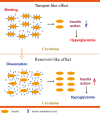Exogenous insulin antibody syndrome (EIAS): a clinical syndrome associated with insulin antibodies induced by exogenous insulin in diabetic patients
- PMID: 29233817
- PMCID: PMC5776673
- DOI: 10.1530/EC-17-0309
Exogenous insulin antibody syndrome (EIAS): a clinical syndrome associated with insulin antibodies induced by exogenous insulin in diabetic patients
Abstract
Insulin has been used for diabetes therapy and has achieved significant therapeutic effect. In recent years, the use of purified and recombinant human insulin preparations has markedly reduced, but not completely suppressed, the incidence of insulin antibodies (IAs). IAs induced by exogenous insulin in diabetic patients is associated with clinical events, which is named exogenous insulin antibody syndrome (EIAS). The present review is based on our research and summarizes the characterization of IAs, the factors affecting IA development, the clinical significance of IAs and the treatments for EIAS.
Keywords: diabetes; exogenous insulin antibody syndrome; hyperglycaemia; hypoglycaemia; insulin antibodies.
© 2018 The authors.
Figures


References
-
- Schernthaner G, Borkenstein M, Fink M, Mayr WR, Menzel J, Schober E. Immunogenicity of human insulin (Novo) or pork monocomponent insulin in HLA-DR-typed insulin-dependent diabetic individuals. Diabetes Care 1983. 6 (Supplement 1) 43–48. - PubMed
-
- Fineberg SE, Galloway JA, Fineberg NS, Rathbun MJ, Hufferd S. Immunogenicity of recombinant DNA human insulin. Diabetologia 1983. 25 465–469. - PubMed
-
- Heding LG, Marshall MO, Persson B, Dahlquist G, Thalme B, Lindgren F, Akerblom HK, Rilva A, Knip M, Ludvigsson J, et al Immunogenicity of monocomponent human and porcine insulin in newly diagnosed type 1 (insulin-dependent) diabetic children. Diabetologia 1984. 27 (Supplement) 96–98. (10.1007/BF00275658) - DOI - PubMed
Publication types
LinkOut - more resources
Full Text Sources
Other Literature Sources

